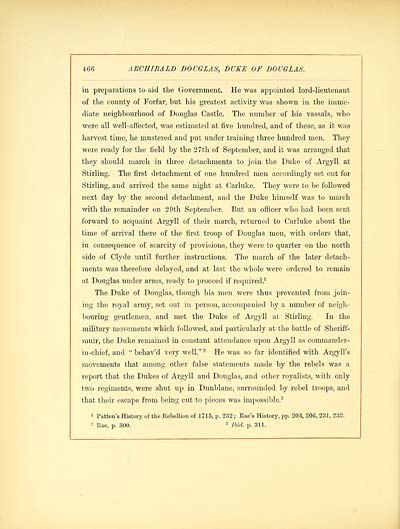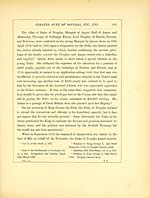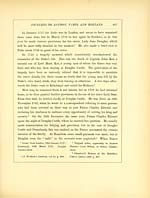Douglas book > Angus memoirs
(490) Page 466
Download files
Complete book:
Individual page:
Thumbnail gallery: Grid view | List view

4C6 ARCHIBALD DOUGLAS, DUKE OF DOUGLAS.
in preparations to aid the Government. He was appointed lord-lieutenant
of the county of Forfar, but his greatest activity was shown in the imme-
diate neighbourhood of Douglas Castle. The number of his vassals, who
were all well-affected, was estimated at five hundred, and of these, as it was
harvest time, he mustered and put under training three hundred men. They
were ready for the field by the 27th of September, and it was arranged that
they should march in three detachments to join the Duke of Argyll at
Stirling. The first detachment of one hundred men accordingly set out for
Stirling, and arrived the same night at Carluke. They were to be followed
next day by the second detachment, and the Duke himself was to march
with the remainder on 29th September. But an officer who had been sent
forward to acquaint Argyll of their march, returned to Carluke about the
time of arrival there of the first troop of Douglas men, with orders that,
in consequence of scarcity of provisions, they were to quarter on the north
side of Clyde until further instructions. The march of the later detach-
ments was therefore delayed, and at last the whole were ordered to remain
at Douglas under arms, ready to proceed if required. 1
The Duke of Douglas, though his men were thus prevented from join-
ing the royal army, set out in person, accompanied by a number of neigh-
bouring gentlemen, and met the Duke of Argyll at Stirling. In the
military movements which followed, and particularly at the battle of Sheriff-
muir, the Duke remained in constant attendance upon Argyll as commander-
in-chief, and " behav'd very well." 2 He was so far identified with Argyll's
movements that among other false statements made by the rebels was a
report that the Dukes of Argyll and Douglas, and other royalists, with only
two regiments, were shut up in Dunblane, surrounded by rebel troops, and
that their escape from being cut to pieces was impossible. 3
1 Patten's History of the Rebellion of 1715, p. 232 ; Raes History, pp. 203, 206, 231, 232.
3 Rae, p. 300. 3 Ibid. p. 311.
in preparations to aid the Government. He was appointed lord-lieutenant
of the county of Forfar, but his greatest activity was shown in the imme-
diate neighbourhood of Douglas Castle. The number of his vassals, who
were all well-affected, was estimated at five hundred, and of these, as it was
harvest time, he mustered and put under training three hundred men. They
were ready for the field by the 27th of September, and it was arranged that
they should march in three detachments to join the Duke of Argyll at
Stirling. The first detachment of one hundred men accordingly set out for
Stirling, and arrived the same night at Carluke. They were to be followed
next day by the second detachment, and the Duke himself was to march
with the remainder on 29th September. But an officer who had been sent
forward to acquaint Argyll of their march, returned to Carluke about the
time of arrival there of the first troop of Douglas men, with orders that,
in consequence of scarcity of provisions, they were to quarter on the north
side of Clyde until further instructions. The march of the later detach-
ments was therefore delayed, and at last the whole were ordered to remain
at Douglas under arms, ready to proceed if required. 1
The Duke of Douglas, though his men were thus prevented from join-
ing the royal army, set out in person, accompanied by a number of neigh-
bouring gentlemen, and met the Duke of Argyll at Stirling. In the
military movements which followed, and particularly at the battle of Sheriff-
muir, the Duke remained in constant attendance upon Argyll as commander-
in-chief, and " behav'd very well." 2 He was so far identified with Argyll's
movements that among other false statements made by the rebels was a
report that the Dukes of Argyll and Douglas, and other royalists, with only
two regiments, were shut up in Dunblane, surrounded by rebel troops, and
that their escape from being cut to pieces was impossible. 3
1 Patten's History of the Rebellion of 1715, p. 232 ; Raes History, pp. 203, 206, 231, 232.
3 Rae, p. 300. 3 Ibid. p. 311.
Set display mode to:
![]() Universal Viewer |
Universal Viewer | ![]() Mirador |
Large image | Transcription
Mirador |
Large image | Transcription
Images and transcriptions on this page, including medium image downloads, may be used under the Creative Commons Attribution 4.0 International Licence unless otherwise stated. ![]()
| Histories of Scottish families > Douglas book > Angus memoirs > (490) Page 466 |
|---|
| Permanent URL | https://digital.nls.uk/96537674 |
|---|
| Attribution and copyright: |
|
|---|---|
| Description | A selection of almost 400 printed items relating to the history of Scottish families, mostly dating from the 19th and early 20th centuries. Includes memoirs, genealogies and clan histories, with a few produced by emigrant families. The earliest family history goes back to AD 916. |
|---|

